- Pound Sterling bounces back ahead of UK inflation data.
- The UK inflation is seen falling further due to BoE’s tight interest rate policy.
- BoE Broadbent turns spotlight on wage growth related inflation.
The Pound Sterling (GBP) extends recovery ahead of the United Kingdom Consumer Price Index (CPI) for November, scheduled for release on December 20. Investors see the UK’s headline and core inflation declining further in November as higher interest rates have dampened household spending on core goods. Prices of goods at factory gates are seen contracting due to poor demand from the slowing domestic and international economy.
The GBP/USD pair recovers amid expectations that softer inflation data would be insufficient to prompt Bank of England (BoE) policymakers to exit from “sufficiently restrictive” monetary policy stance and escalate hopes for more rate cuts in 2024. Inflation in the UK economy is highest among western nations and a call for dovish stance could fire up price index again
Hawkish commentary from BoE Deputy Governor Sarah Breeden has strengthen the Pound Sterling further. Breeden endorsed restrictve monetary policy for a longer period. While asked about guidance on interest rates, Breeden said "I have no pre-determined policy path in mind,"
Daily Digest Market Movers: Pound Sterling capitalizes on upbeat market mood
- Pound Sterling rebounds from 1.2650 ahead of the UK’s inflation data for November, which will be published on Wednesday at 07:00 GMT.
- The UK inflation data is expected to continue easing further amid higher interest rates by the Bank of England, which has dampened the overall consumer spending and sluggish economic activities.
- According to the preliminary consensus, monthly headline inflation is expected to have grown by 0.2% against a stagnant performance in October. The annual headline CPI is seen declining to 4.4% against the former reading of 4.6%.
- UK’s core inflation that strips off volatile food and Oil prices is estimated to have dropped to 5.5% versus. 5.7% in October.
- In the event if the data shows a continuation of easing inflation it would be a sign of relief for BoE policymakers, which have been favouring a tightening regime for interest rates to achieve price stability.
- Meanwhile, monthly Producer Price Index (PPI) for input and final products are seen contracting by 0.6% and 0.1% respectively. This indicates that producers were forced to reduce prices of goods at their factory gates due to a sharp decline in consumers’ demand.
- Investors have already started raising bets for four or five rate cuts in 2024 amid easing inflationary pressures. However, BoE Deputy Governor Ben Broadbent said that more evidence is needed to conclude that the price index is in a clear downtrend.
- Ben Broadbent, on Monday, highlighted disparities in labour market measures, as the Office for National Statistics (ONS) shifted to an experimental series method to calculate employment data due to lower responses.
- Broadbent warned that sticky wage growth could force the BoE to keep interest rates elevated for a longer period.
- Last week, the BoE emphasized keeping interest rates in a restrictive territory to ensure the achievement of price stability after keeping interest rates unchanged at 5.25%.
- Meanwhile, the US Dollar Index (DXY) falls from 102.50 as discussions about rate cuts by the Federal Reserve (Fed) outweighs.
- The broader appeal for the USD Index remains weak as the Fed is numero uno among western central bankers, when it comes to discussing cutting rates in 2024.
- Last week, median projections from Fed policymakers showed that interest rates would be reduced by 75 basis points (bps) in 2024, with core Personal Consumption Expenditure price index (PCE) falling to 2.4%.
- On Monday, San Francisco Fed Bank President Mary Daly said that it would be appropriate to lower borrowing costs in 2024 amid progress in inflation declining towards 2% this year.
Technical Analysis: Pound Sterling stabilizes above 1.2700
Pound Sterling finds an interim support near 1.2630 after a steep correction from almost four-month high of 1.2800. The broader trend of the GBP/USD pair is bullish as it is forming a Cup and Handle chart pattern. A decisive break above the handle and round-level resistance of 1.2800 could open room for upside towards the psychological resistance of 1.3000. The 20-day Exponential Moving Average (EMA) around 1.2600 will likely continue to provide support to the Pound Sterling bulls.
BoE FAQs
What does the Bank of England do and how does it impact the Pound?
The Bank of England (BoE) decides monetary policy for the United Kingdom. Its primary goal is to achieve ‘price stability’, or a steady inflation rate of 2%. Its tool for achieving this is via the adjustment of base lending rates. The BoE sets the rate at which it lends to commercial banks and banks lend to each other, determining the level of interest rates in the economy overall. This also impacts the value of the Pound Sterling (GBP).
How does the Bank of England’s monetary policy influence Sterling?
When inflation is above the Bank of England’s target it responds by raising interest rates, making it more expensive for people and businesses to access credit. This is positive for the Pound Sterling because higher interest rates make the UK a more attractive place for global investors to park their money. When inflation falls below target, it is a sign economic growth is slowing, and the BoE will consider lowering interest rates to cheapen credit in the hope businesses will borrow to invest in growth-generating projects – a negative for the Pound Sterling.
What is Quantitative Easing (QE) and how does it affect the Pound?
In extreme situations, the Bank of England can enact a policy called Quantitative Easing (QE). QE is the process by which the BoE substantially increases the flow of credit in a stuck financial system. QE is a last resort policy when lowering interest rates will not achieve the necessary result. The process of QE involves the BoE printing money to buy assets – usually government or AAA-rated corporate bonds – from banks and other financial institutions. QE usually results in a weaker Pound Sterling.
What is Quantitative tightening (QT) and how does it affect the Pound Sterling?
Quantitative tightening (QT) is the reverse of QE, enacted when the economy is strengthening and inflation starts rising. Whilst in QE the Bank of England (BoE) purchases government and corporate bonds from financial institutions to encourage them to lend; in QT, the BoE stops buying more bonds, and stops reinvesting the principal maturing on the bonds it already holds. It is usually positive for the Pound Sterling.
Information on these pages contains forward-looking statements that involve risks and uncertainties. Markets and instruments profiled on this page are for informational purposes only and should not in any way come across as a recommendation to buy or sell in these assets. You should do your own thorough research before making any investment decisions. FXStreet does not in any way guarantee that this information is free from mistakes, errors, or material misstatements. It also does not guarantee that this information is of a timely nature. Investing in Open Markets involves a great deal of risk, including the loss of all or a portion of your investment, as well as emotional distress. All risks, losses and costs associated with investing, including total loss of principal, are your responsibility. The views and opinions expressed in this article are those of the authors and do not necessarily reflect the official policy or position of FXStreet nor its advertisers. The author will not be held responsible for information that is found at the end of links posted on this page.
If not otherwise explicitly mentioned in the body of the article, at the time of writing, the author has no position in any stock mentioned in this article and no business relationship with any company mentioned. The author has not received compensation for writing this article, other than from FXStreet.
FXStreet and the author do not provide personalized recommendations. The author makes no representations as to the accuracy, completeness, or suitability of this information. FXStreet and the author will not be liable for any errors, omissions or any losses, injuries or damages arising from this information and its display or use. Errors and omissions excepted.
The author and FXStreet are not registered investment advisors and nothing in this article is intended to be investment advice.
Recommended content
Editors’ Picks

EUR/USD clings to strong daily gains near 1.0400
EUR/USD remains on track to post strong gains despite retreating from the session high it set above 1.0430. The positive shift in risk mood, as reflected by the bullish action seen in Wall Street, forces the US Dollar to stay on the back foot and helps the pair hold its ground.

GBP/USD surges above 1.2500 as risk flows dominate
GBP/USD extends its recovery from the multi-month low it set in the previous week and trades above 1.2500. The improving market sentiment on easing concerns over Trump tariffs fuelling inflation makes it difficult for the US Dollar (USD) to find demand and allows the pair to stretch higher.

Gold firmer above $2,630
Gold benefits from the broad-based US Dollar weakness and recovers above $2,630 after falling to a daily low below $2,620 in the early American session on Monday. Meanwhile, the benchmark 10-year US Treasury bond yield holds above 4.6%, limiting XAU/USD upside.

Bitcoin Price Forecast: Reclaims the $99K mark
Bitcoin (BTC) trades in green at around $99,200 on Monday after recovering almost 5% in the previous week. A 10xResearch report suggests BTC could approach its all-time high (ATH) of $108,353 ahead of Trump’s inauguration.

Five fundamentals for the week: Nonfarm Payrolls to keep traders on edge in first full week of 2025 Premium
Did the US economy enjoy a strong finish to 2024? That is the question in the first full week of trading in 2025. The all-important NFP stand out, but a look at the Federal Reserve and the Chinese economy is also of interest.

Best Forex Brokers with Low Spreads
VERIFIED Low spreads are crucial for reducing trading costs. Explore top Forex brokers offering competitive spreads and high leverage. Compare options for EUR/USD, GBP/USD, USD/JPY, and Gold.